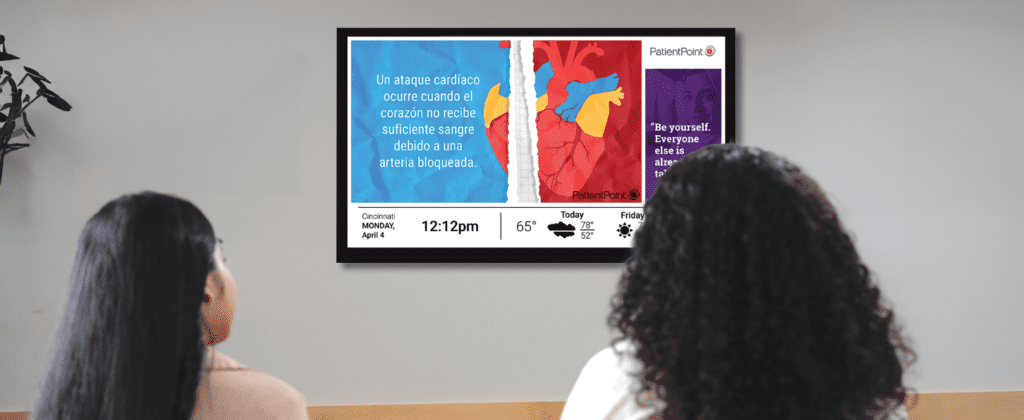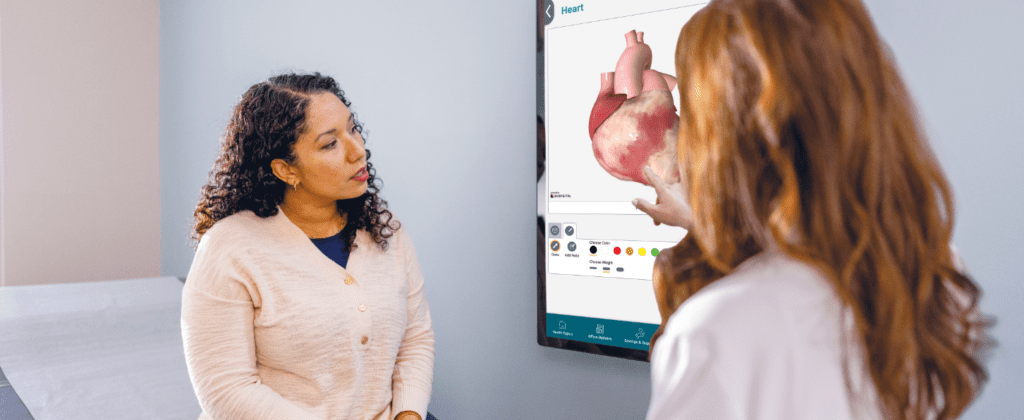Strategically incorporating engagement technology in physician offices fosters active patient participation and significantly improves health outcomes. We’ve seen this in action. One PatientPoint location saw a 45% increase in mammograms over a period of 12 months compared to similar locations without PatientPoint.* The difference? Patients were exposed to consistent messaging on engagement technology, including waiting room and exam room devices, about the importance of breast cancer screenings. This spurred patients to talk to their doctor and schedule necessary health services.
When a patient is engaged in their care, they’re actively contributing to discussions with their provider, following their treatment plan and taking their medication as prescribed. Implementing key technologies in your office is essential for enhancing patient engagement, improving health outcomes and boosting your practice’s efficacy.
Empowering health literacy

If a patient doesn’t understand their health condition or how medication can be beneficial, they may neglect to follow their treatment plan, leading to further complications. While doctors play a pivotal role in explaining diagnoses to patients using simplified language, time constraints limit the depth of these discussions in the exam room.
Add digital signage to the waiting room to prepare patients to have meaningful conversations with their doctor. This technology, sometimes called waiting room TV or healthcare TV, should provide relevant health education, healthy living tips and compliance messages. Look for programming that also allows for inspirational, relaxing and entertaining content. Nearly half of all patients are anxious when visiting the doctor.** Helpful education placed alongside relaxation content can calm patients, putting them in the right frame of mind to talk to their doctor.
Then in the exam room, you can bridge the final communication gap by integrating interactive devices, featuring multi-media, specialty-specific health information that helps create more effective conversations. Exam room engagement technology should provide both patients and clinicians with educational resources. For patients, look for a solution that is easy to use and navigate so they can quickly find health information relevant to their visit. Engagement solutions should also provide information that is useful for those who are newly diagnosed and those at various stages of their health journey.
For doctors and other clinical staff, look for a solution that gives them easy access to teaching tools—including an anatomy library, procedure videos and support and savings programs. Having these tools optimizes the provider’s time in the exam room.
Optimize treatment adherence

Maximize the impact of waiting room and exam room devices by providing not only health information but also treatment information. From reminders on medication adherence to insights into various treatment options, engagement devices can guide patients actively through clear and concise communication.
Extend this guidance beyond the office by sending a post-appointment text message, detailing instructions. This can help clear up any miscommunication or confusion that the patient may feel leaving the office.
Delivering relevant information beyond the office
In today’s digital world, it is necessary to send specialty-specific patient education home digitally. Whether it’s a recap of health information discussed during the appointment or additional education the patient needs and/or wants. That way they can choose to review the education in a less stressful environment or share it with their family.
Traditionally, doctors have provided this information in the form of take-home papers. While many are still fans of printed information, it’s also easy for a patient to lose or accidentally throw away. Consider sending information via text, email and QR code scan. When evaluating different exam room touchscreens, check to see if any have the ability to send information right from the device to the patient’s phone.
To have success adding these patient engagement technologies, be sure to establish clear team communication about the benefits of each device and how they should be used. Feel free to also share our findings on how in-office programs increase screenings at our provider partner locations, leading to better outcomes. Check out the data in our free e-book.

